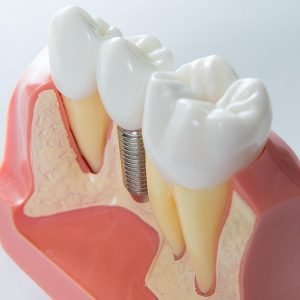Bone Grafting
Bone Grafting Yeronga
 Bone grafting procedures are usually required when there is not enough bone available to support dental implants.
Bone grafting procedures are usually required when there is not enough bone available to support dental implants.
A bone grafting procedure attempts to correct a deficiency or defect in a patient’s jawbone.
This correction can be performed by using bone taken from the patient, or by using specific materials, called “bone substitutes”.
Loss of bone volume can be caused by a variety of factors due to:
- infection
- trauma
- gum disease
Many patients choose to use their own bone for a bone graft, but one may also opt to receive bone from a donor.
If one chooses to use their own bone, it is normally extracted from behind the teeth furthest in the rear, the chin, or from other areas in the body such as the hip or shin.
Using your own bone for a bone graft will require having a donor site and surgical site simultaneously. This can cause additional healing time and pain.
However, many people prefer using their own bone in a bone graft in spite of these effects.
Types of Bone Grafting
Bone Grafting. Bone grafting involves adding bone material to the affected area.
Bone grafting materials can be easily obtained from other areas of the jaw or from pre-packaged bone graft mineral.
Socket Grafting. When a tooth is extracted, the bone around the extraction site tends to collapse inward and eventually shrink.
However, bone can be preserved and even improved by adding bone mineral, with a dissolving collagen sponge, to the site.
Sinus Grafting. The maxillary sinuses are empty pockets behind your cheeks, above your upper back teeth.
Sometimes, after an upper molar is extracted and the socket heals, only a thin layer of bone will remain underneath the sinus.
If the sinus floor is thin, grafting to the area may be required before implants can be installed.
Ridge Augmentation. When teeth have been missing for a long time, the bone left in the area may become too narrow and/or too short for implant placement.
In these cases, small, carefully prepared and fitted grafts can be placed at the implant sites to provide adequate bone thickness and/or height.
Uses of Bone Grafting
Bone grafting procedures aim to accomplish the following:
Saving Teeth — When severe gum disease causes bone loss, teeth can become loose and at risk of being lost.
To save teeth, the bone around them can be regenerated through grafting, increasing bone support and maintaining the teeth.
Tooth Extractions — Nowadays, it is very common to deposit bone grafting material into the extraction site after a tooth has been pulled.
That way, should you want to replace your tooth with a dental implant afterwards, that option will be readily available.
Dental Implants — In implant dentistry, a small titanium post embedded in the jawbone is attached to a natural-looking dental crown, permanently replacing the missing tooth.
Implants require good bone structure and density to be used to their full functionality and to achieve high success rates.
If you experience bone loss, a bone grafting procedure can help regenerate enough bone to place the implant successfully.
What to Expect During a Bone Grafting Procedure
The bone grafting procedure usually requires only local anaesthesia, though oral or IV sedatives can also be used for a higher state of relaxation.
Since a small cut is made in your gum tissue to access the bone that will receive the graft, you may experience pain in the graft site post-surgery.
This can usually be addressed by over-the-counter anti-inflammatory medications and/or painkillers, as well as regular ice therapy.
Any discomfort should only last for a day or two. Then, over the next months, your body will replace the graft with your own bone, reversing progressive bone loss you have experienced.
Bone Grafting in Yeronga
Bone loss can harm your oral health and can make you look older than you are. But in many cases, bone can regenerate and strengthen with obvious benefits to both oral health and aesthetics.
The continuing advancements of grafting technology not only promote new bone growth but also control growth for optimal results. Indeed, bone grafting can create new opportunities for better mouth function and a more attractive smile.
Visit your dentist in Yeronga for a consultation today!
Ria Family Dental serves local communities in Yeerongpilly, Annerley, Tarragindi, Rocklea, Fairfield, Tennyson, Graceville, Chelmer, and Moorooka.
Bone Grafting in Yeronga
#1. Book online now
#2. Call 0451 359 356
#3. Visit us at 451 Fairfield Rd in Yeronga
CONTACT INFO
Ria Family Dental
Address: 451 Fairfield Rd, Yeronga, QLD 4104
Mobile: 0451 359 356
Email: info@riadental.com.au
OPENING HOURS
Monday - Friday: 8:30 AM – 7:00 PM
Saturday: 8:30 AM to 1:00 PM every 2nd and 4th Saturdays
Sunday: Closed

PARKING/PUBLIC TRANSPORT
FREE off street parking and close to public transport.
LOCATION
Ria Family Dental is located in Yeronga only short stroll from Yeronga Station, Yeronga Commuter Park and Rowlinson Park.
Yeronga dentist also serving local communities in Yeerongpilly, Annerley, Tarragindi, Rocklea, Fairfield, Tennyson, Graceville, Chelmer and Moorooka.


